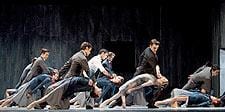It’s one of the great contradictions in art history: In times of severe censorship great art often thrives, as writers and artists are challenged to find ever more inventive ways to outfox, even attack, the censors.
In a similar vein, 20th-century choreographers took the ossified 19th-century art form of ballet and bent it into fantastical new shapes. It was still recognizably ballet — not modern dance — choreographers still respected certain rules and techniques while simultaneously commenting on and subverting those rules.
The National Ballet of Canada’s exciting shorts program exemplifies the benefits — and limits — of that subversive creativity with celebrated works by two American masters, George Balanchine and Jerome Robbins, and a world premiere from Canadian-born star Aszure Barton.
Bursting with violent passions, Barton’s new piece, Watch Her, is sandwiched between the Balanchine and Robbins; the comparisons are fascinating but not always in Barton’s favour.
Designed by Yannik Larivée, Watch Her opens with a grungy concrete wall spanning the entire stage as a small ensemble plucks and whistles through Lera Auerbach’s reconstructed version of Pergolesi’s Stabat Mater. A man (Kevin Bowles) sits on a chair near a small square opening in the wall. He climbs up and falls through. The wall rises to reveal three more walls — tall, imposing, a prison. Bridgett Zehr enters at the head of two lines of women in flowing sheath dresses as men in suits line the walls, watching.
Lust and longing, fear and domination play back and forth among the soloists. Zehr, and the other female principals Sonia Rodriguez and Heather Ogden, give controlled, sexually charged performances of Barton’s unsettling, at times quirky, choreography. Also commanding attention is Robert Stephen in a testosterone-fuelled display of anguish.
Barton has a wonderful theatricality. At one point a line of heads appears at the top of the back wall. Startling. She also has sure command of her own unique movement vocabulary, still very much in the classical tradition. But it can be unwieldy. Unlike the Balanchine and Robbins works, it’s difficult at times to understand why Barton breaks up classical moves and layers on more contemporary ones.
There is a problem with clarity; so much is going on it’s difficult to focus. And Christopher Dennis’s atmospheric lighting doesn’t always help. It’s a case of the whole being less than a sum of its parts.
The piece displays an unresolved tension between abstraction and narrative. Whether the prison is real, a memory or a nightmare, I keep looking in vain to place that first man in relationship to the other dancers. With so many pairings and ensembles, however, perhaps they’re meant to be experienced only as states of being, as something more abstract. And instead of focusing our attention, the corps is deployed in an increasingly diffuse manner, overwhelming Barton’s intense duets and solos.
Watch Her is a dense, disturbing piece that needs more than one viewing. But its mix of exacting technique and expressive innovation sits wonderfully on a company like the National. The whole evening showcases the company’s depth of talent and the dancers’ discipline and artistry.
Balanchine’s The Four Temperaments heralded a new form of ballet, an abstract, modern, American form, when it debuted in 1946 with the Ballet Society (later the New York City Ballet). With thrust hips and bent wrists, you really sense Balanchine pushing classical positions to the limit. The elegant Zehr and Patrick Lavoie set the bar high in the opening Theme, followed by evocative performances from soloists Zdenek Konvalina, Aleksandar Antonijevic and others. Despite the piece’s austerity, with dancers’ faces kept as neutral masks, you always feel the intended emotion of any section.
Equally at home on the Broadway stage, Robbins always brought the common touch, a popular idiom, to his ballets. But Glass Pieces from 1983 is Robbins at his most coolly classical. The opening is pure energy. The company, in bright, multicoloured tights, walk briskly across the stage, everyone crisscrossing to the repetitive strains of Philip Glass. Totally abstract, it still evokes instantly the bustle of New York streets. Couples keep breaking into very classical pairings, carving out private spaces amid the hubbub.
The second section sees the women’s corps slowly slink across the back of the stage in silhouette — a jerky step, a ploppy plié, a spin — one after the other creating a long line (my date calls it a disturbing homage to that pinnacle of 19th-century dance, La Bayadère). They form a cheeky frame for the romantic pas de deux downstage between Zehr and Konvalina.
By the third section, Robbins increasingly breaks the classical lines. The men come stomping out like horses, one leg barely bending. Small groups charge about with increasing momentum. The whole company is deployed for the whirling finale. Pure Busby Berkeley. Irresistible. The piece leaves you brimming with joy.


 Why you can trust Xtra
Why you can trust Xtra


